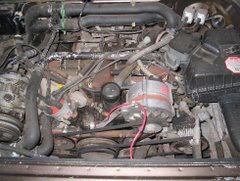After welcoming, opening questions and introductions, we had an extensive safety orientation from Bill. (My summary: batteries are heavy. They have acid in them. They can explode. Also, don't forget, they can shock you. Plus, you should not use any of the shop tools unless you've been trained on them. Any questions?)
We also toured the NMTCC facilities, visiting the carpentry, auto body, welding and machine shops. I loved this sign in the welding classroom:

Bill then reviewed some of the major components necessary in an EV conversion and some of the things you should consider before undertaking a conversion. As regular readers of this blog know, there are bolt-in conversion kits available for some makes and models of cars. Everything has been pre-fabricated to measure, and when you buy one of these, there are no design decisions to make and usually no surprises. Well, there is no bolt-in kit for a Volkswagen Vanagon -- so we have design decisions galore to make, and probably plenty of surprises along the way!
Now on to the rest of the photos:
 Bill lectures to a full house.
Bill lectures to a full house. In the afternoon, Larry and John -- both faculty members at NMTCC -- and our two youngest participants, Mike and Keith, were assigned to begin creating the battery racks. These metal racks will be bolted to the van, ensuring that those heavy, acid-containing, explosive and (oh yeah) high-voltage batteries are safely contained. The first step was sketching them out on paper (above)
In the afternoon, Larry and John -- both faculty members at NMTCC -- and our two youngest participants, Mike and Keith, were assigned to begin creating the battery racks. These metal racks will be bolted to the van, ensuring that those heavy, acid-containing, explosive and (oh yeah) high-voltage batteries are safely contained. The first step was sketching them out on paper (above) then measuring the available angle iron.
then measuring the available angle iron. Then there was more measuring,
Then there was more measuring, and more still.
and more still. Finally it was time to do some cutting!
Finally it was time to do some cutting! Here Mike is operating the foot pedal to make the slice.
Here Mike is operating the foot pedal to make the slice. Meanwhile the rest of the class had been given a worksheet showing how measurements are taken of the clutch assembly and transaxle in order to fabricate the adaptor plate.
Meanwhile the rest of the class had been given a worksheet showing how measurements are taken of the clutch assembly and transaxle in order to fabricate the adaptor plate. Bill assigned them to practice taking those measurements themselves.
Bill assigned them to practice taking those measurements themselves. So there was more measuring to be done!
So there was more measuring to be done! Meanwhile back in the welding shop ...
Meanwhile back in the welding shop ...
... Larry shows Mike and Keith how comparing diagonal measurements can help you tell whether something is square!

The afternoon wasn't all measuring. The old batteries were moved out of the van
 and after the transmission worksheet there were battery configuration diagrams to play with. The above image shows the three cells in each of the e-Van's 6-volt batteries. The batteries themselves need to be wired in series -- positive to negative, of course -- and this little chart will help determine what the most efficient cable connections will be.
and after the transmission worksheet there were battery configuration diagrams to play with. The above image shows the three cells in each of the e-Van's 6-volt batteries. The batteries themselves need to be wired in series -- positive to negative, of course -- and this little chart will help determine what the most efficient cable connections will be. This is an occasion for group problem-solving
This is an occasion for group problem-solving and lots of discussion and trying things out.
and lots of discussion and trying things out.It was a fun day to watch and document! Stay tuned, and thanks for following along!





No comments:
Post a Comment